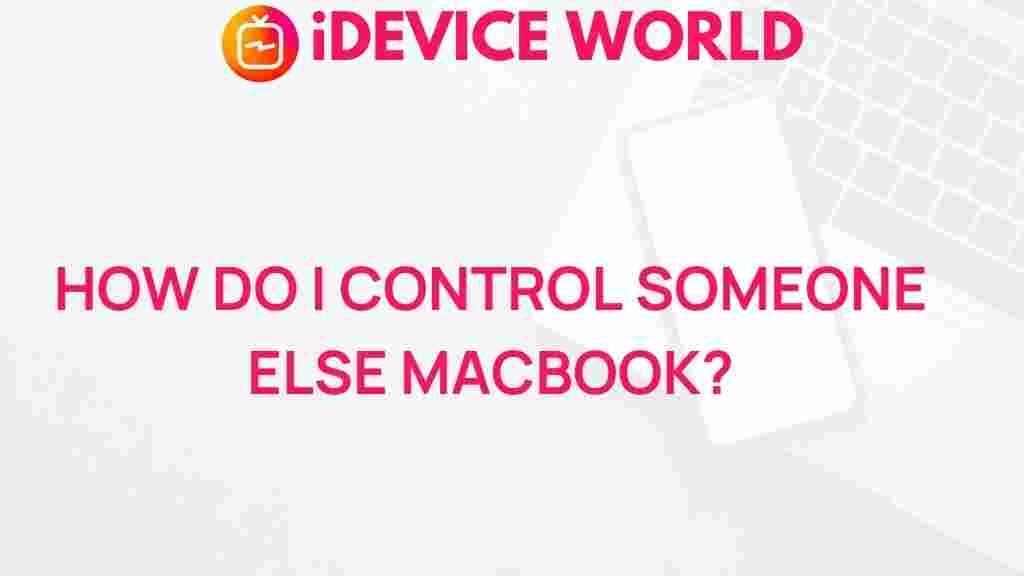Unveiling the Secrets of Remote Macbook Control
In today’s fast-paced world, the need for flexibility and mobility is paramount. Whether you are working from home, traveling, or simply enjoying a coffee at your favorite café, having the ability to control your Macbook remotely can greatly enhance your productivity. This article explores the various methods and tools available for remote Macbook control, ensuring you can access your files and applications from anywhere.
Understanding Remote Macbook Control
Remote control allows you to access your Macbook as if you were sitting right in front of it. This capability can be incredibly beneficial for:
- Accessing files and applications when you’re away from your desk.
- Providing tech support to friends or family.
- Working on projects seamlessly across multiple devices.
Before diving into the methods for remote control, it’s essential to understand how these connections work. Typically, remote access software creates a secure connection between your controlling device and the Macbook, allowing you to see its screen and interact with its applications.
Choosing the Right Remote Access Software
Several applications facilitate remote Macbook control. Here are some popular choices:
- TeamViewer: A powerful remote access tool that offers cross-platform support and easy setup.
- Chrome Remote Desktop: A free service that works through the Google Chrome browser, making it accessible and user-friendly.
- AnyDesk: Known for its speed and efficiency, AnyDesk is an excellent choice for remote Macbook control.
- Apple Remote Desktop: This is a paid application by Apple, specifically designed for Mac users, providing robust features for network management.
Setting Up Remote Access on Your Macbook
Now that you have chosen your remote access software, let’s go through the step-by-step process of setting it up.
Step 1: Install the Remote Access Software
Visit the official website of the software you chose and download the application. For example:
- For TeamViewer, download the Mac version and follow the installation instructions.
- For Chrome Remote Desktop, you need to have Google Chrome installed first.
Step 2: Configure Your Macbook Settings
After installation, open the application and follow these configurations:
- Enable remote access by following the on-screen prompts.
- Set up your account and create a secure password to prevent unauthorized access.
- Make sure your Macbook’s firewall settings allow the remote software to connect.
Step 3: Connect from Another Device
Once your Macbook is configured, you can connect from another device:
- Open the remote access software on the controlling device.
- Log in using the credentials you created during setup.
- Select your Macbook from the list of available devices.
- Enter the password if prompted.
Tips for Using Remote Macbook Control Effectively
To maximize your experience with remote Macbook control, consider these tips:
- Use a Stable Internet Connection: A reliable and fast internet connection will ensure smooth performance.
- Optimize Your Display Settings: Adjust the resolution settings for better visibility and usability during remote sessions.
- Keep Your Software Updated: Regular updates can improve performance and security.
Troubleshooting Common Issues
While remote access is generally seamless, you may encounter some issues. Here are troubleshooting tips for common problems:
- Connection Issues: Ensure both devices have a stable internet connection and are not blocked by firewalls.
- Software Not Responding: Try restarting both the remote access software and your Macbook.
- Performance Lag: Reduce the video quality settings within the remote access application to improve performance.
Securing Your Remote Macbook Access
Security should be a top priority when accessing your Macbook remotely. Here are some essential tips:
- Use Strong Passwords: Ensure your remote access account has a strong, unique password.
- Enable Two-Factor Authentication: If your software supports it, enable two-factor authentication for added security.
- Log Out When Not in Use: Always log out of the remote session when you’re finished to prevent unauthorized access.
Conclusion
Remote Macbook control is an invaluable tool that can enhance your productivity and flexibility in today’s digital landscape. By selecting the right software, configuring your settings correctly, and following security best practices, you can enjoy seamless access to your Macbook from virtually anywhere.
Whether you’re working remotely, providing tech support, or simply accessing files on the go, mastering remote access will empower you to make the most of your Macbook. Embrace the freedom and convenience that comes with remote control, and stay connected to your work, no matter where you are.
For more information about improving your Macbook experience, check out our guide on optimizing Macbook performance.
If you have further questions about remote access or specific software features, feel free to reach out to your software’s support team or check out their official documentation.
This article is in the category Guides & Tutorials and created by iDeciveWorld Team
